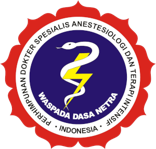Relationship Between Simple Oxygen Extraction Ratio to Cardiac Index and Mean Arterial Pressure in Septic Shock Patient Treated in ICU Dr. Sardjito Hospital Yogyakarta
Abstract
Objective: Discover any relation between simplified oxygen extraction ratio with cardiac index and mean arterial pressure in shock septic condition at ICU of RSUP Dr Sardjito Yogyakarta
Method : 32 subject with crossectional study was performed by inclution criteria such as : patient in ICU diagnosed as shock septic, more than 18 years old, inerted cvc in right atrium, inserted arterial line in arterial radialis or brachialis which connected mostcare. BGA (arterial and venous ) sampel was taken by I-STAT® together with recording mean arterial pressure (MAP) and cardiac index value.
Result : Correlation between O2ER and cardiac index p=0,009 (p<0,05) with r -0,456. Correlation between O2ER and MAP p=0,006 (p<0,05) with r-0,474.
Conclusion :Anesthesia management of TGA TGA cases is to avoid reducing cardiac output and SVR and keep the PVR lower than the SVR.
Keywords
Full Text:
PDFReferences
1. M S. Singer,M., Deutschman, C.,Seymour,C, Christopher,W., Manu,S., Gordon R., et al. The Third International Consensus definitions for Sepsis and Septic Shock (sepsis-3).JAMA2016; 315(8):801810.doi:10.1001/jama.2016.0287. Third Int Consens Defin Sepsis Septic Shock. 2016;801–10.
2. C, Seymour, iwashyna j. Seymour,C,. Liu V, Iwashyna,J., et al (2016) Assessment of clinical criteria for sepsis: for the third international consensus definitions for sepsis and septic shock (Sepsis‐3). JAMA 315(8):762–774 Title. Assess Clin criteria sepsis third Int Consens Defin sepsis septic Shock. 2016;762–74.
3. pierre,a, ferhat, bruno conrad. Pierre, A., Ferhat, Bruno, Conrad., 2014. High Versus Low Blood-Pressure Target in Patients with septic shock. New England Journal Medicin: 370:1583-1593. New Engl J Med. 2014;1583–93.
4. Montassier,E., Batard,E., Segard, J.,Martinage,A., Conte,P., Potel G. Montassier,E., Batard,E., Segard, J.,Martinage,A., Conte,P., Potel,G. Base excess in an accurate predictor of elevated lactate in ED septic patients. Am J Emergency Medicine 2014;30(1):184-7.doi:10.1016/j.ajem.2010.09.033.Epub 2010. Am J Emerg Med. 2014;184–7.
5. Mallat,J., Lemyze,M., Tronchon,L., Vallet, B., Thevenin D. Mallat,J., Lemyze,M., Tronchon,L., Vallet, B., Thevenin, D. Use of venous-to-arterial carbon dioxide tension difference to guide resuscitation therapy in septic shock.World J Critical Care Medicine 2016;5(1):47-56.doi:10.5492/wjccm.v5.i1.4. World J Crit Care Med. 2016;47–56.
6. Levy, M., Rhodes, A., Philiups, GS., Sean, R., Christa, A., Richard B. Levy,M., Rhodes,A., Philiups,GS., Sean,R., Christa,A., Richard,B.et al. Surviving Sepsis Campaign: association between performance metrics and outcomes in a 7.5-year study. Crit Care Med 2015; 43(1):3-12.doi:10.1097/CCM.000000000000072. Crit Care Med. 2015;3–12.
7. McLellan, S.A., and Walsh TS. McLellan, S.A., and Walsh, T.S., 2004. Oxygen Delivery and Haemoglobin. British Journal of Anesthesia Volume 4 Number 4. 23-126. Br J Anesth. 2004;4:23–126.
8. Patel,N., Justin,D., Durland,A., Makaryus N. Patel,N., Justin,D., Durland,A., Makaryus,N. 2022.Physiology, Cardiac Index.2(cited 2022 July.https://www.ncbi.nlm.nih.gov/books/NBK539905/10.5005/jp-journals-10071-23246. Physiol Card Index [Internet]. 20222; Available from: https://www.ncbi.nlm.nih.gov/books/NBK539905/10.5005/jp-journals-10071-23246
9. Carl,E., Rhodes, Deanna,D., Matthew V. Carl,E., Rhodes, Deanna,D., Matthew,V. Physiology, Oxygen Transport.2021(cited 2022 july 1). Available from https://www.ncbi.nlm.nih.gov/books/NBK538336/. Physiol Oxyg Transp [Internet]. 2022; Available from: https://www.ncbi.nlm.nih.gov/books/NBK538336/
10. Torio,C., Andrews R. Torio,C., Andrews,R.National inpatient hospital costs: the most expensive conditions by payer. Healthcare Cost and Utilization Project (HCUP) Statistical Briefs.2011(cited 2022 June 3). Available from Aug;http://www.ncbi.nlm.nih.gov/books/NBK169005/. Healthc Cost Util Proj Stat Briefs [Internet]. 2022; Available from: http://www.ncbi.nlm.nih.gov/books/NBK169005/
11. Fleischmann C, Scherag A, Adhikari NK, Mellhammar L, Cassini A AB. Fleischmann C, Scherag A, Adhikari NK, Mellhammar L, Cassini A, Allegranzi B et al (2020) Assessment of global incidence and mortality of hospital‐treated sepsis. Current estimates and limitations. Am J Respir Crit Care Med 193(3):259–272 . Am J Respir Crit Care Med. 2020;259–72.
12. Vallet B. Vallet, B., 1998. Vascular Reactivity And Tissue Oxygenation. Intensive Care Med; 24. 1998. 24 p.
13. Sumesh, A., Pratik, A. T. Sumesh,A., Pratik,A., Tantia. Physiology of Oxygen Transport and its Determinants in Intensive Care Unit.2021(cited 2022 July 1). Available from https://www.ncbi.nlm.nih.gov/books/NBK538336/#__NBK538336_ai. 2022; Available from: https://www.ncbi.nlm.nih.gov/books/NBK538336/#__NBK538336_ai
14. Shannon,M., Fernando, Alexandre,T., Monica T, Wei,C., Bram,R., Andrew,S., Jeffrey P. Shannon,M., Fernando, Alexandre,T., Monica T, Wei,C., Bram,R., Andrew,S., Jeffrey,P. 2018.Prognostic Accuracy of the Quick Sequential Organ Failure Assessment for Mortality in Patients With Suspected Infection : A Systematic Review and Meta-analysis. Anna. Ann Intern Med. 2018;266–75.
15. Leone, M., Pierre, A., Peter, R., Jean, L., Claude M. Leone, M., Pierre, A., Peter, R., Jean, L., Claude, M.2015.Optimizing mean arterial pressure in septic shock: a critical reappraisal of the literature. Critical care:19:101. Crit care. 2015;
Refbacks
- There are currently no refbacks.








